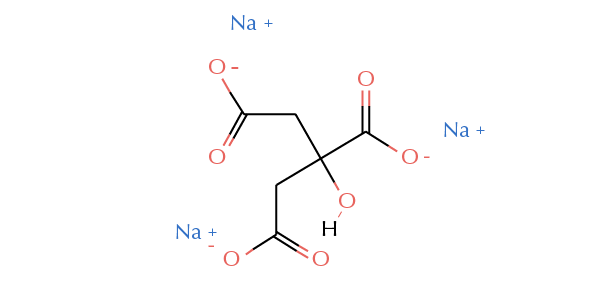What Is Sodium Citrate?
Sodium citrate is used in cosmetics and skincare products primarily to control the pH level of your product. It also helps to preserve formulations and prevent bacteria and microbial growth.
Sodium citrate is the sodium salt of citric acid, a weak organic acid that is naturally found in both plants and animals, particularly in citrus fruits. In fact, citric acid is what gives citrus fruits their characteristic acidic taste. One example is lemon juice, which contains about 5 to 8 percent citric acid. Citric acid was first isolated in 1784 by the chemist Carl Wilhelm Scheele, who crystallized it from lemon juice.
While citric acid can be extracted from citrus fruits, over 99% of the world’s citric acid output is produced by microbial fermentation. Industrial, large scale production of citric acid is accomplished via mycological fermentation of crude sugar stocks like molasses by strains of Aspergillus niger.
The citrate salts are produced by the same fermentation process, but are simply crystallized in the presence of appropriate alkaline solutions. For instance, sodium citrate is produced when citric acid is crystallized with sodium hydroxide.

Sodium Citrate
the good:Sodium citrate helps to manage the pH of formulations, allowing for versatility in terms of other key ingredients that can be used. It also helps to reduce microbial growth which ensures safer, longer lasting products.
the not so good:Sodium citrate doesn’t produce any irritation or sensitivity when used in skincare and cosmetics.
Who is it for?All skin types except those that have an identified allergy to it.
Synergetic ingredients:Works well with most ingredients
Keep an eye on:Nothing to keep an eye on here.
What Effect Does Sodium Citrate Have On The Skin?
In cosmetics and skincare products, sodium citrate primarily functions as a buffering agent to control the pH level, but may also be used as a preservative.
pH
As a buffering agent, sodium citrate functions to establish and hold the pH of a product. If you remember back to highschool science, pH stands for ‘potential hydrogen’ and it refers to the level of acidity or alkalinity in a given solution. Basically, how acidic or basic something is.
The pH scale ranges from 0 to 14. A pH of 7 is neutral, while a pH less than 7 is acidic and a pH greater than 7 is basic or alkaline. Sodium citrate can buffer solutions in the pH range of about 3 to 6.2. Buffering refers to a mild change in pH.
The skin’s normal pH is slightly acidic, typically between 4.75 and 5.5. This acidity of the skin is termed the “acid mantle” and is maintained by sebaceous or oil glands, sweat glands, and normal skin flora.
The acid mantle provides a film of amino and lactic acids and oils that effectively protect skin from environmental factors such as allergens, pollutants,and bacteria. These environmental factors can contribute to conditions like sensitive skin, acne, and even signs of aging.
There are many factors that can disrupt the delicate balance of the skin’s acid mantle, both internally and externally. Our skin becomes more acidic as we age in response to our lifestyle and environment. Everything that comes in contact with our skin, such as cosmetic products, sun, water, pollution, etc., can contribute to the breakdown of the acid mantle. Ultimately, this interferes with the skin’s ability to protect itself.
It is important to balance the pH of cosmetics and skincare products in order to maintain the skin’s normal pH as closely as possible. If a product is too acidic it may irritate the skin or cause a stinging sensation. However, if a product is too alkaline it will deplete your skin of vital, natural lipids. Skin that is too alkaline can be more susceptible to acne because a certain level of acidity is needed to inhibit bacterial growth.
Additionally, a disrupted acid mantle can inhibit the absorption of topical skin care products. By using an ingredient like sodium citrate, cosmetic manufacturers can adjust the pH of their formulations, resulting in a product that is better tolerated by the skin.
Preservative
In addition to functioning as a buffering agent, sodium citrate is used as a preservative. The use of preservatives is necessary in most products to prevent degradation caused by microorganisms, and to protect the product from inadvertent contamination during use.
Microbial contamination of products, especially those used around the eyes and on the skin, can lead to problems like skin irritation and infection. Preservatives like sodium citrate help to prevent such problems.
Is Sodium Citrate Vegan?
Sodium citrate is a vegan ingredient. It is usually synthetically made or derived from plant-based sources.
If you are looking for a vegan product it is best to hceck that the other ingredients in the formulation are also vegan and that the brand is cruelty-free.
Is Sodium Citrate Safe?
In 2014, the Cosmetic Ingredient Review Expert Panel reviewed scientific literature and data on the safety of citric acid and its esters and salts, including sodium citrate. The Cosmetic Ingredient Review Expert Panel is a group responsible for the independent evaluation of the safety and efficacy of skincare and cosmetic ingredients.
Their data revealed that at concentrations used in cosmetics and skincare products, citric acid and its esters and salts were not eye irritants, nor did they cause skin irritation or allergic skin reactions. Thus, the Expert Panel concluded that the available scientific data showed that citric acid and its esters and salts were safe under current conditions of use in cosmetics and personal care products.
References:
https://pubmed.ncbi.nlm.nih.gov/24861367/







